Table of Contents
Cell Structure and Functions Notes.
Cells are the tiny units of life that emerged on Earth at least 3.5 billion years ago. Every living thing is made up of cells, starting from the blue whales to the archaebacteria that live inside volcanoes. Our body contains approximately 40 trillion (4×1013) cells (the human brain contains around 80 billion cells).
The cells are doing millions of things at once in our body such as electron transport, pumping blood, filtering urine, digesting food, making protein, storing fat, and that’s just the stuff you’re not thinking about!
What is the cell?
- The call is defined as the basic structural, functional, and biological unit of all known living organisms. The cells are the autonomous , self-replicating the smallest unit of life.
- They are also called the “building blocks of life”.
- The term ‘cell’ came from a Latine word ‘cella’ which means “small room“.
- A branch of biology where we study cells is called cell biology, cellular biology, or cytology.
- In 1665, English scientist and architect Robert Hooke first discovered the cell.
Cell Theory
The German scientists Theodor Schwann, Matthias Schleiden, and Rudolf Virchow proposed the cell theory. According to this theory;
- All living organisms are composed of cells.
- A cell is the basic structural and functional unit of life.
- All cells arise from pre-existing cells.
The modern cell theory contain these following postulates;
- Cells transfer Genetic information from one cell to another cell.
- Energy flows within the cells.
- All the cells contain the same chemical composition.
Cell Organelles/Cell Structure
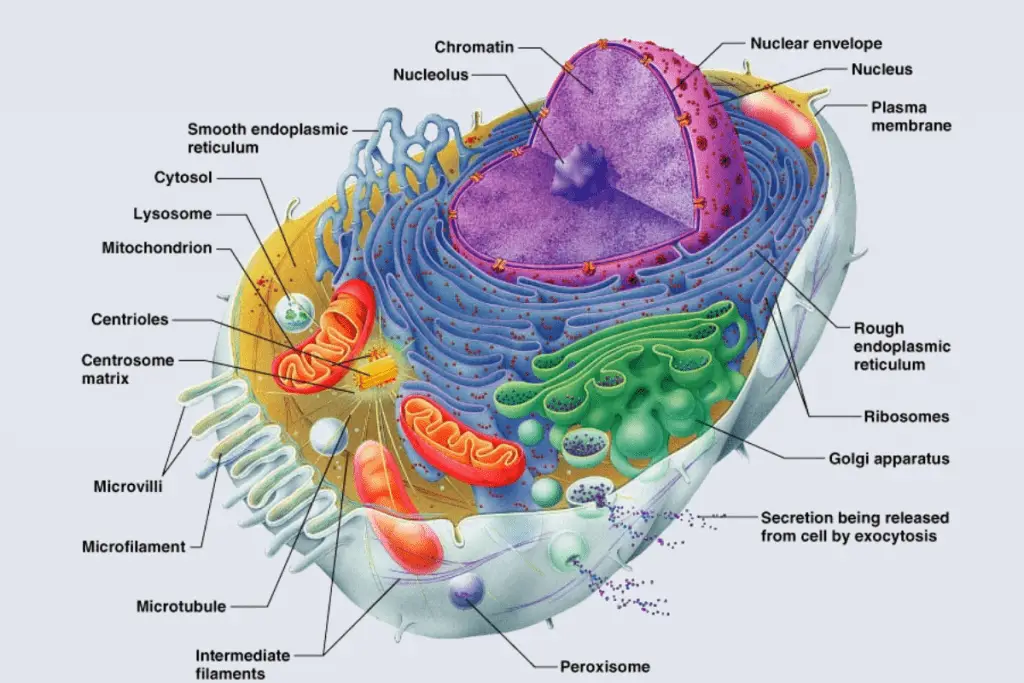
1. Cell Membrane or plasma membrane
- The cytoplasm of a cell is surrounded by the cell membrane.
- The cell membrane is also known as the plasma membrane.
- In animal cells, the plasma membrane serves as an outer boundary, whereas in prokaryotes and plant cells is covered by a cell wall.
- The thickness of a cell membrane is around 4 and 10 nanometers.
Structure and Chemical composition of Membrane
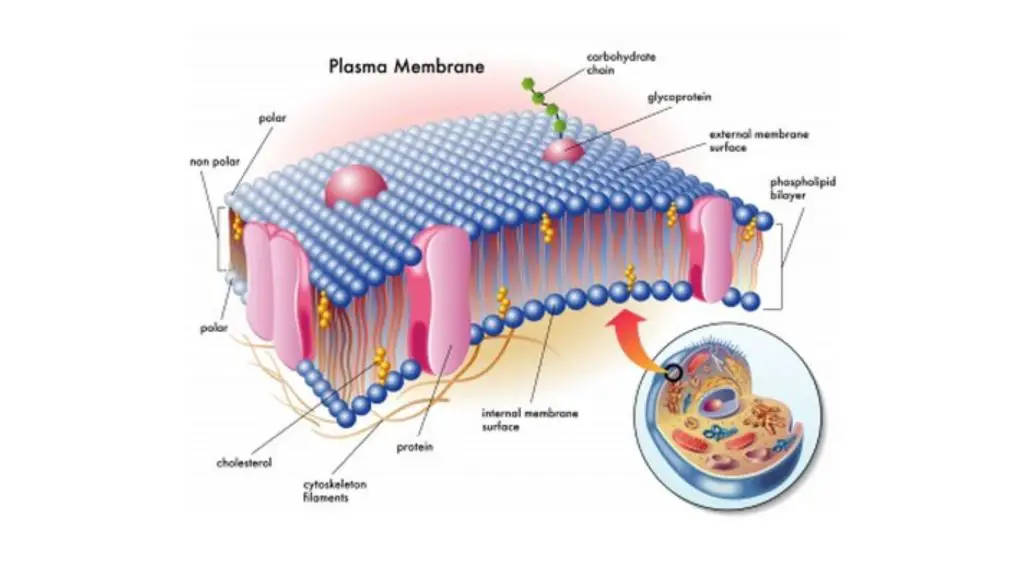
- Membrane Lipids:
- The cell membrane is composed of a lipid bilayer
- There are present two types of membrane lipids such as phospholipids and sterols (generally cholesterol).
- This membrane lipid contains both lipid-soluble and a water-soluble region, that is why they are called “amphiphilic”.
- The head portion of Phospholipid is attached with two long hydrophobic fatty acid chains, this portion is insoluble in water and dissolves readily in organic solvents which gives it a lipid character.
- A phosphoryl group remains attached to another part of the head, this portion of the phospholipid dissolves in water.
- Membrane Proteins:
- The cell membrane also contains two types of proteins such as extrinsic protein and the intrinsic protein.
- The extrinsic proteins remain loosely attached with the phosphoryl surface of the lipid bilayer by ionic bonds or calcium bridges.
- Whereas the intrinsic proteins remain embedded within the phospholipid bilayer.
- Intrinsic proteins are composed of 20- to 24-amino acids long sequences, which are extended through the internal regions of the cell membrane.
Functions of Cell Membrane
- During tissue formation and cell fusion, the cell membrane allows the interaction between cells.
- The cell membrane provides a shape to the cell and encloses the cell and its components from the external environment.
- It helps in the transport of essential compounds that are required for the survival of the cell.
2. Cell Wall
- The cell membrane or plasma membrane is surrounded by a rigid and stiff structure which is called the cell wall. It provides structure and protection to the cell.
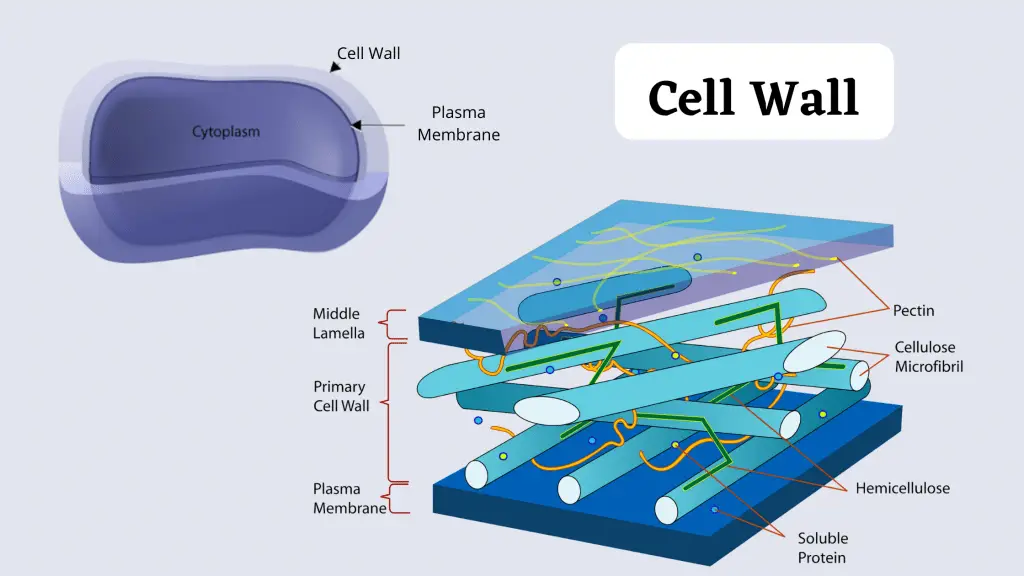
Structure and composition of Cell wall
- The plant cell is composed of cellulose, hemicellulose, and proteins.
- The fungal cell wall is composed of chitin, glucans and proteins.
- The bacteria cell wall is composed of peptidoglycan.
- The cell wall has a multilayered structure, which consists of three-layer such as a middle lamina, a primary cell wall, and a secondary cell wall.
- The middle lamina is composed of polysaccharides which help in binding or in adhesion with neighbor cells.
- After the middle lamina, a cellulose layer is present which is called the Primary layer.
- The secondary layer of the cell wall is composed of cellulose and hemicellulose.
Functions of the Cell Wall
- It helps in the transportation of substances into the cell.
- Cell wall functions as a barrier between the interior cellular components and the external environment.
- The cell wall is maintaining the definite shape, strength, rigidity of the cell.
- It also protects the cell from mechanical stress and physical shocks.
- Cell walls control cell expansion during the intake of water and also prevent water loss from the cell.
3. Cytoskeleton
- It is a complex, dynamic network that interlinks protein filaments within the cytoplasm of all cells, such as bacteria and archaea.
- The cytoskeleton is extended from the cell membrane to the cell nucleus.
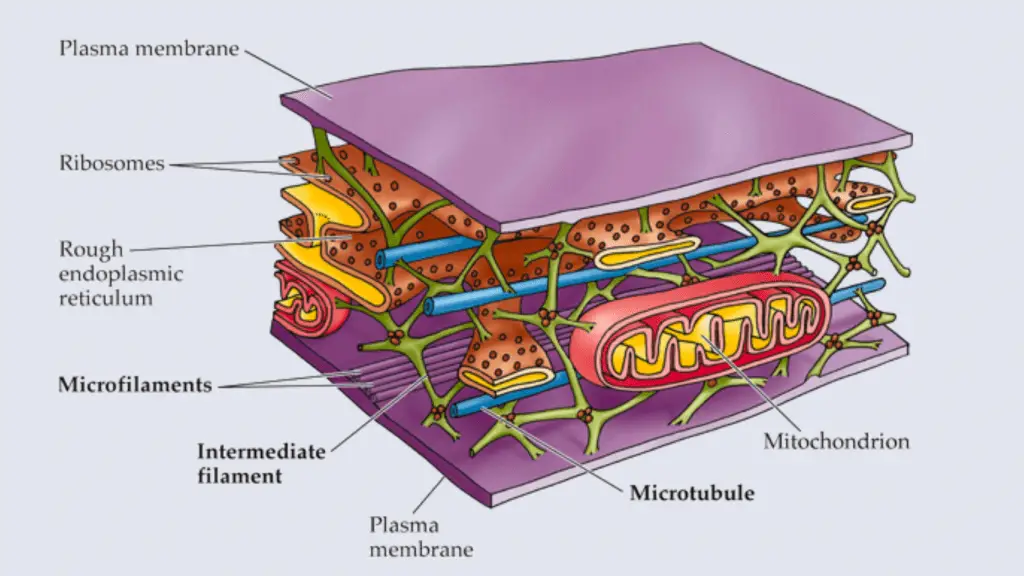
Structure and composition of Cytoskeleton
- In Eukaryotic cells, the Cytoskeleton is composed of microfilaments, microtubules, and intermediate filaments.
- The diameter of a microfilament is about 7 nm which is made up of many linked monomers of a protein known as actin These actions are combined and formed a double helix structure.
- The Intermediate filaments are composed of multiple strands of fibrous proteins that are wound together. They have an average diameter of 8 to 10 nm.
- The Microtubules have a diameter of about 25 nm which is composed of tubulin proteins (tubulin protein consists of two subunits, α-tubulin, and β-tubulin). These proteins are arranged to form a hollow, straw-like tube.
Functions of Cytoskeleton
- The cytoskeleton maintains the shape of the cell.
- It helps in cell locomotion.
- It organizes the structures and activities of the cell.
4. Capsule
- The capsule is present at the outside of the cell membrane and cell wall in some bacteria.
- The capsule can be detected by staining them with India ink or methyl blue. The standard stains are not used to stain them because they cannot penetrate the capsule.
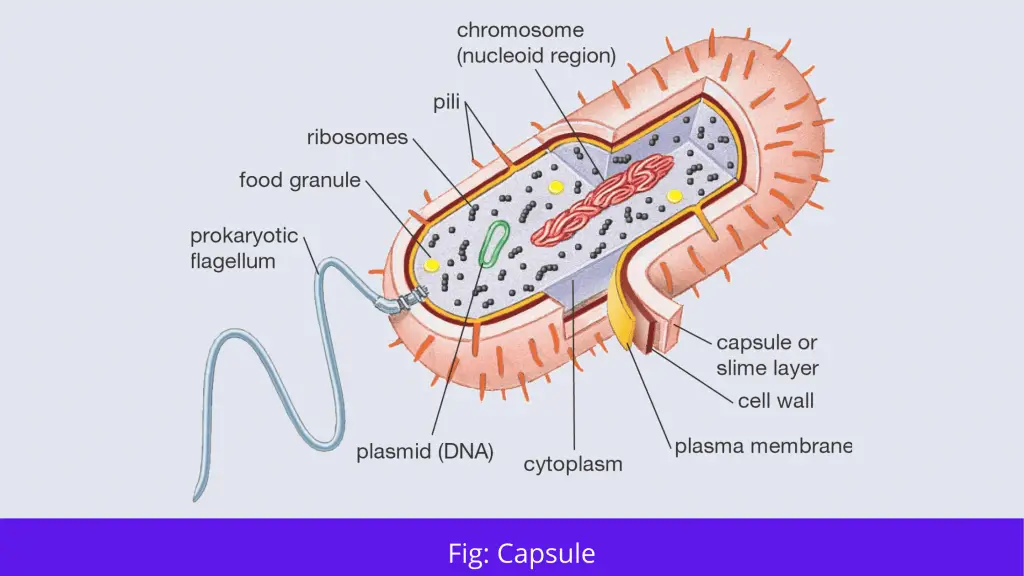
Structure and composition of Capsule
- The Capsule in bacteria cells consist of polysaccharide except Bacillus anthracis, because their capsule consists of poly-D-glutamic acid.
Function of Capsule
- Protecting the cell wall from different antibacterial agents, thus it is considered a virulence determinant.
- It protects the bacteria from desiccation.
- Allow in adhesion of bacteria to surface.
- It prevents phagocytosis.
5. Flagella
- The bacterial flagellum are long and thick thread-like appendages which are stretched from cytoplasm through the cell membrane(s) and extrude through the cell wall.
- There are present different types of flagella based on their number and location such as Monotrichous, Peritrichous, Lophotrichous, and Amphitrichous.
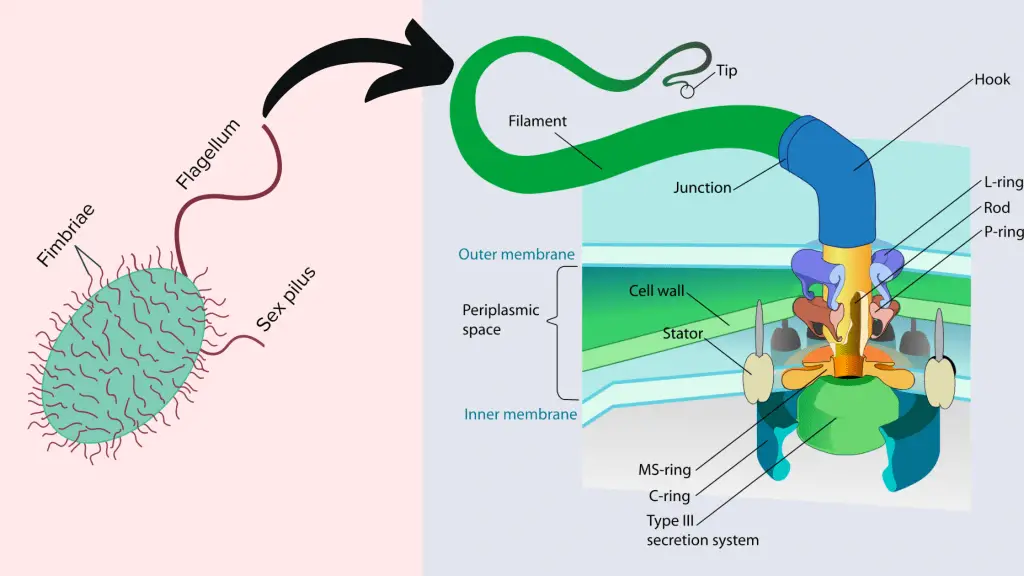
Structure and composition
- Bacterial flagella is about 20-nanometer-thick and composed of the protein flagellin.
- The flagella has three important parts such as Basal body, Hook, and Filament.
- The basal body consists of four rings such as P-ring, M-S-ring, L-ring and C-ring.
- Filaments are thin hair like structure and Hook is the broader area present at the base of the filament.

Function
- Helps in movement of organisms.
- It is also used as a secretary organelle in Chlamydomonas.
- They detect the changes in pH and temperature.
- Some eukaryotes use flagellus to enhance their reproduction rates.
6. Fimbriae
- Fimbriae also known as pilus or pili which is a short, thin, hair-like filament located at the bacterial surface.
- Fimbriae is thinner and shorter than a flagellum.
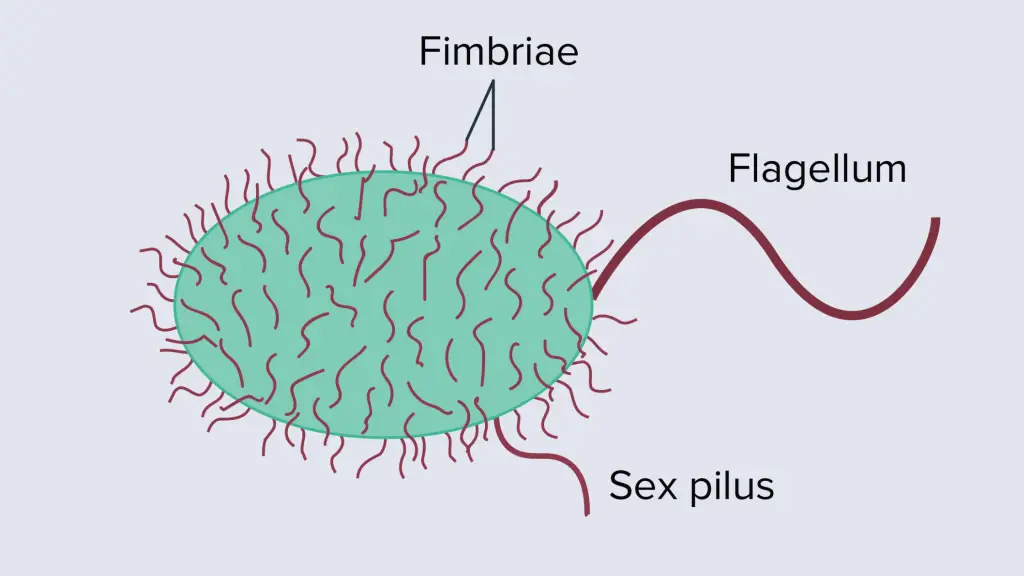
Structure and composition
- The diameter of fimbriae ranges from 3–10 nanometers and several micrometers long.
- The fimbriae are made up of pilin proteins which are antigenic in nature.
Functions
- It helps in attachment of bacterial cells with the host cells.
- It also determines the virulence properties of several bacteria.
7. Cell Organelles
Cell organelles are referred to when those vital organelles are present within the cell and perform one or more vital functions.
There are present several types of organelles such as nucleus, golgi apparatus, mitochondria, chloroplasts, peroxisomes and lysosomes, etc.
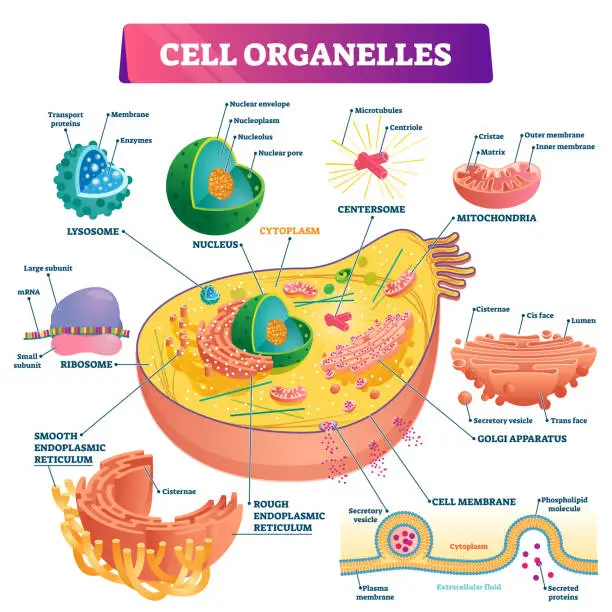
(i). Cell nucleus:
- The nucleus stored the genetic information of the cell that is why it is called the information center of the cell. It is also called “brain of the cell”, because it controls the functions of other organelles.
- In eukaryotic organisms the nucleus is surrounded by a nuclear membrane, and a nuclear envelope, which is separating it from the cell cytoplasm.
- It contains double-stranded, spiral-shaped deoxyribonucleic acid (DNA) molecules within its membrane. In Prokaryotic cells, the nucleus is absent whereas the genetic material distributed in the cytoplasm.
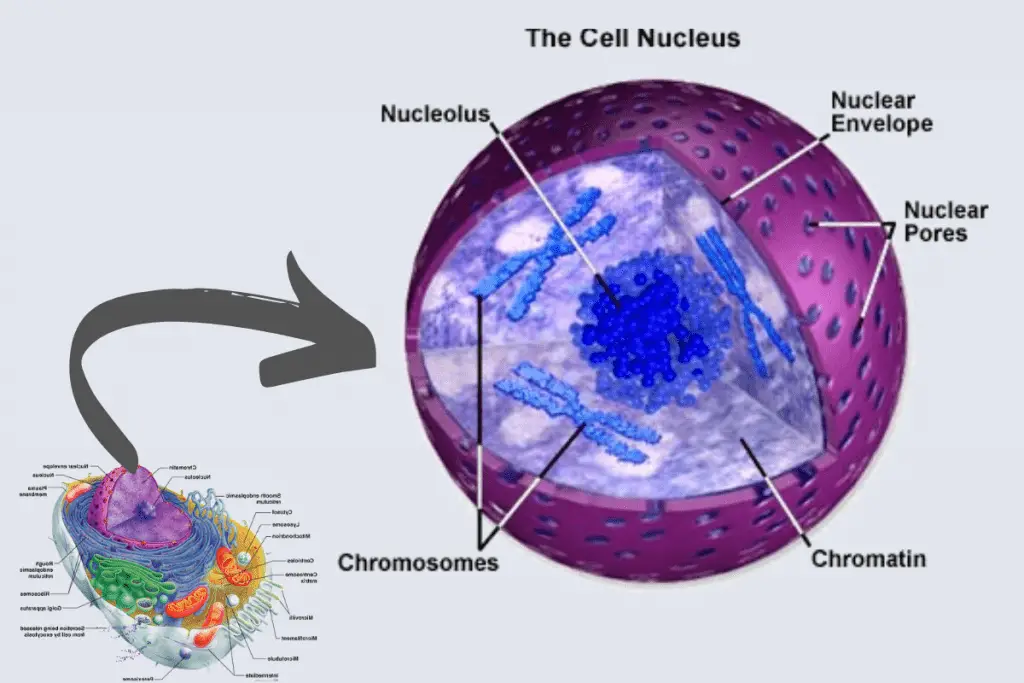
Structure of Nucleus
- The nucleus has a diameter of 6 micrometres (6 × 10−6 metre), and contains about 1.8 metres of DNA.
- Nucleus has several important parts such as chromatin (Genetic material), nuclear envelope, nucleoplasm and nucleolus.
- The nuclear envelope is a lipid bilayer, which contains two layers such as outer and an inner phospholipid bilayer. This envelope separates the chromatin and nucleolus from cytoplasm. The nuclear envelope contains several pores which helps in import and export of proteins and RNA from cytoplasm.
- Chromatin is a dense, compact fibre which is formed by the combinations of both DNA and proteins.
- The nucleoplasm is referred to the portion which is located within the envelope.
- The nucleolus has four important components such as Fibrillar Centers, Granular Components, Dense Fibrillar Components, and Nucleolar vacuoles. It occupied the 25% volume of the nucleus. It performed the assembling of ribosomes and synthesis of rRNA.
Functions
- Nucleus stored the genetic material and proteins(DNA or RNA).
- It controls the protein synthesis, cell division, growth, and differentiation.
- It produces messenger RNA (mRNA) for protein synthesis.
(ii). Mitochondria
- Mitochondria is referred to as the powerhouse of a cell because it generates energy for the cell.
- It is a self-replicating organelles which is found in both plant and animal cells in various numbers, shapes, and sizes.
- It produces ATP or energy by oxidative phosphorylation of end products which are arising from the cytoplasmic metabolism.
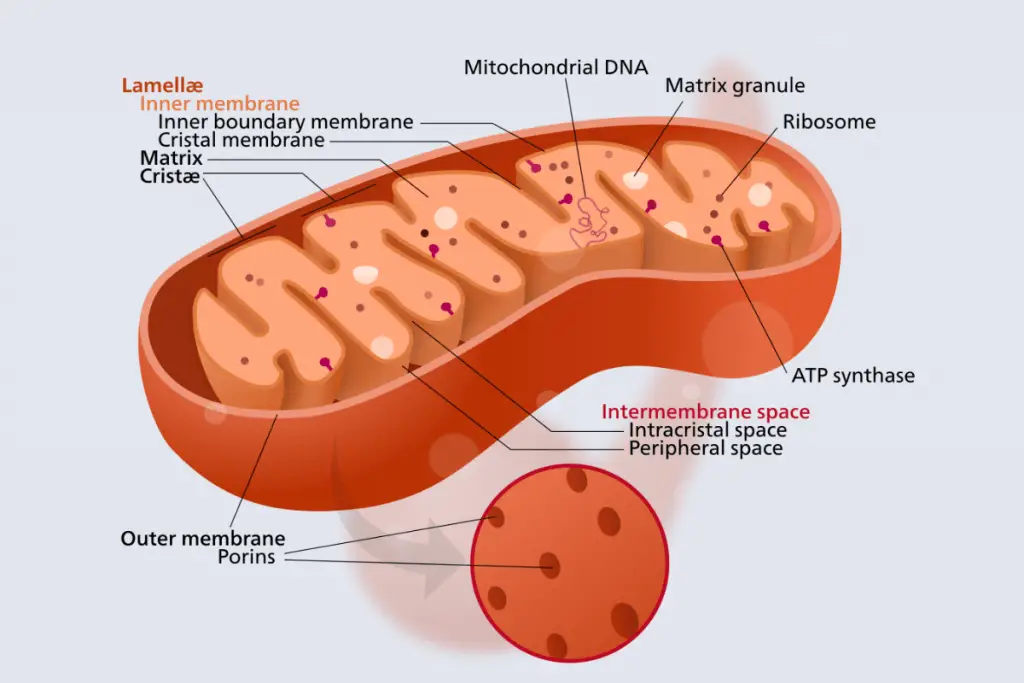
Structure of Mitochondria
- Mitochondria has two distinct membranes such as inner layer and outer layer.
- The outer layer is smooth whereas the inner layer is folded and forms finger-like structures which are called cristae.
- The inner membrane enclosed space is called matrix, this space contains a fluid which is a mixture of metabolic products, enzymes, and ions.
Functions of Mitochondria
- It produces energy in the form of ATP which is required for the proper functioning of cell organelles.
- It helps to detoxify the ammonia.
- Mitochondria produces different types of components of blood and segments of hormones.
- It assists the process of apoptosis.
- It also balanc the amount of Ca+ ions within the cell.
Read More
(iii). Chloroplast
- Chloroplasts are a type of plastid which are found in cells of plants and green algae, which help in photosynthesis. In photosynthesis it converts the light energy into chemical energy as a result it produces oxygen and energy-rich organic compounds.
- They contain pigments such as chlorophyll a and chlorophyll b, which helps in photosynthesis. Because of this pigment they appear as green colour which is distinguished from other types of plastids.
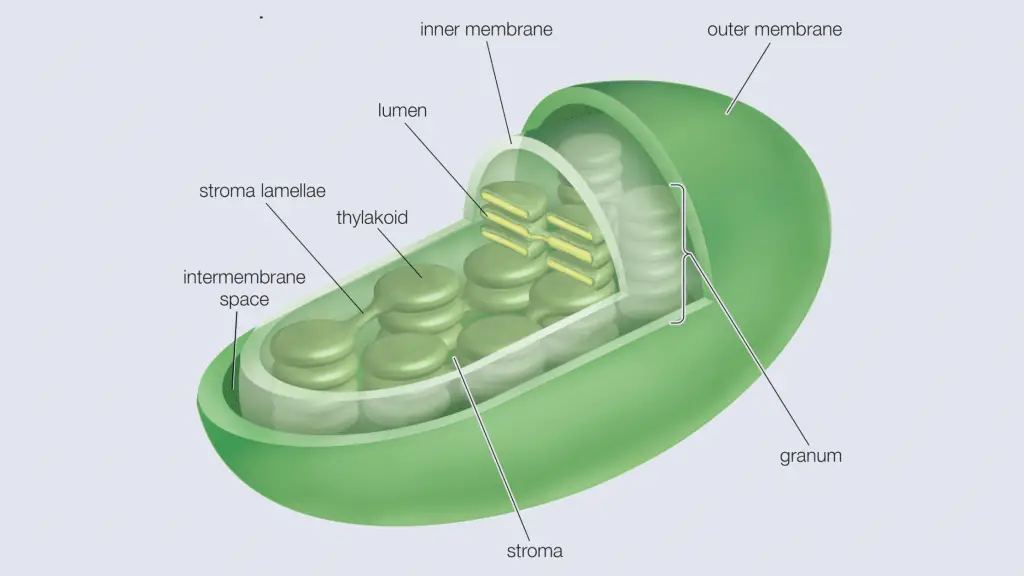
Structure of Chloroplast
- Chloroplasts are round, oval, or disk-shaped with a diameter of 5–7 μm and thickness is about 1–2 μm (1 μm = 0.001 mm).
- The chloroplast is surrounded by a double membrane which has two layers such as the outer and inner layers. There is a gap between the outer and inner layer which is called intermembrane space.
- The porous nature of outer and inner membranes in chloroplast help in transport of different materials.
- Inside the inner membrane it contains thylakoids. There is another internal membrane which is extensively folded and characterized by the presence of thylakoids; it is known as the thylakoid membrane. In some plants the thylakoids are tightly stacked which is called grana.
- Between the inner membrane and thylakoid membrane it contains dissolved enzymes, starch granules, and copies of the chloroplast genome within a matrix which is known as stroma.
Function of Chloroplast
- It performed the light-independent and light-dependent reactions during photosynthesis.
(iv). Centriole
- Centrioles are located near the nucleus but they appear only during cell division, they work in the process of mitosis and meiosis.
- Centrioles are cylindrical in shape and made up of a protein called tubulin. They mainly appear in most eukaryotic cells.

Structure of Centriole
- Centriole consists of nine sets of microtubules, each in groups of three known as triplet microtubules.
- The Triplet microtubules consist of three concentric rings of microtubules which makes it very strong.
- A special protein is bound with each triplet which provides the shape of centriole.
- A amorphous material known as the pericentriolar material is surrounded by the triplet microtubules.
Function of Centriole
- During the cell division centriole helps in the formation of spindle fibers.
- They help in the formations of cilia and flagella.
(v). Cytoplasm
- The semifluid substance which is located between the nucleus and the cellular membrane is called cytoplasm.
- Different types of organelles are suspended within the cytoplasm such as ribosomes, mitochondria, golgi bodies, centriole, lysosomes and peroxisomes, etc.
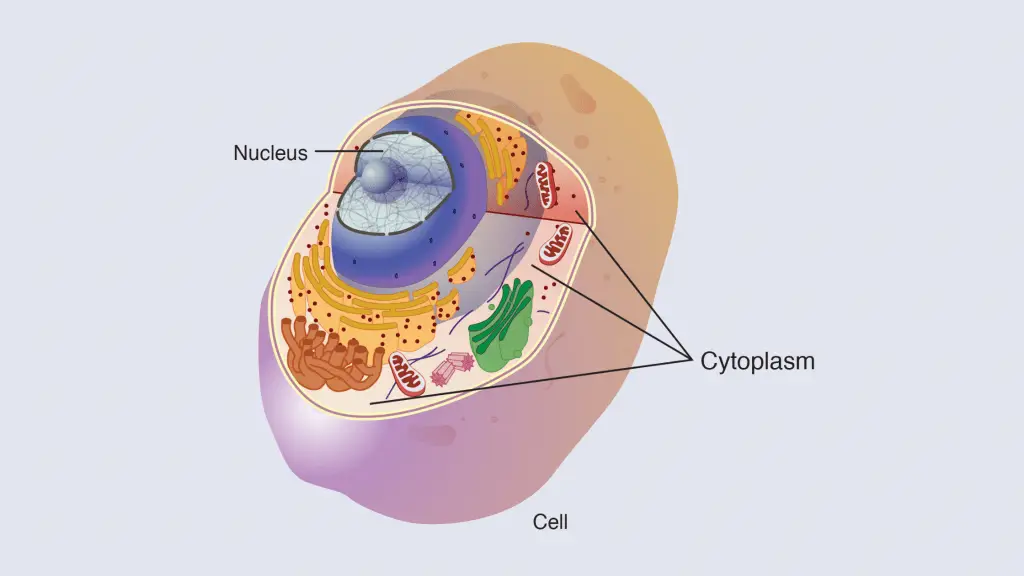
Structure of Cytoplasm
- Cytoplasms consist of three main components such as cytosol, organelles and inclusions.
- Cytosol is a gel-like substance in which other organelles remain suspended. It occupies about 70% of the cell volume. Cytoplasm is a mixture of cytoskeletal filaments, dissolved molecules, and water.
- Organelles are referred to as membrane-bound structures, which perform specific functions and remain suspended within the cytoplasm. Organelles include mitochondria, the endoplasmic reticulum, the Golgi apparatus, vacuoles, lysosomes, etc.
- Cytoplasmic inclusions are insoluble small particles which are suspended in the cytosol.
Function of Cytoplasm
- Most of the Cellular and enzymatic reactions occur within the cytoplasm.
- Cytoplasm protects the other organelles and genetic materials from damage which can occur due to collision or change in the pH.
- Cytoplasm helps in distribution of nutrients and conducting the movement of cell organelles within the cell by a process is called cytoplasmic streaming.
(vi). Endosomes
- It is a membrane-bound vesicle formed by endocytosis.
- Endosomes are found in animal cell cytoplasm.
Structure of Endosomes
- Endosomes are three types including early endosomes, late endosomes, and recycling endosomes.
- The early endosome is composed of tubular-vesicular networks.
- The late endosome has several close-packed intraluminal vesicles but lacks tubules.
- The recycling endosome is made of tubular structures.
Function of Endosomes
- It sorts the material before it reaches the degradative lysosome.
(vii). Golgi Apparatus/ Golgi Complex/ Golgi Body
- Golgi Body mainly found in eukaryotic cells and they modify and transport molecules from endoplasmic reticulum to their destination.
- They are found in cytoplasm next to the endoplasmic reticulum and near the cell nucleus.
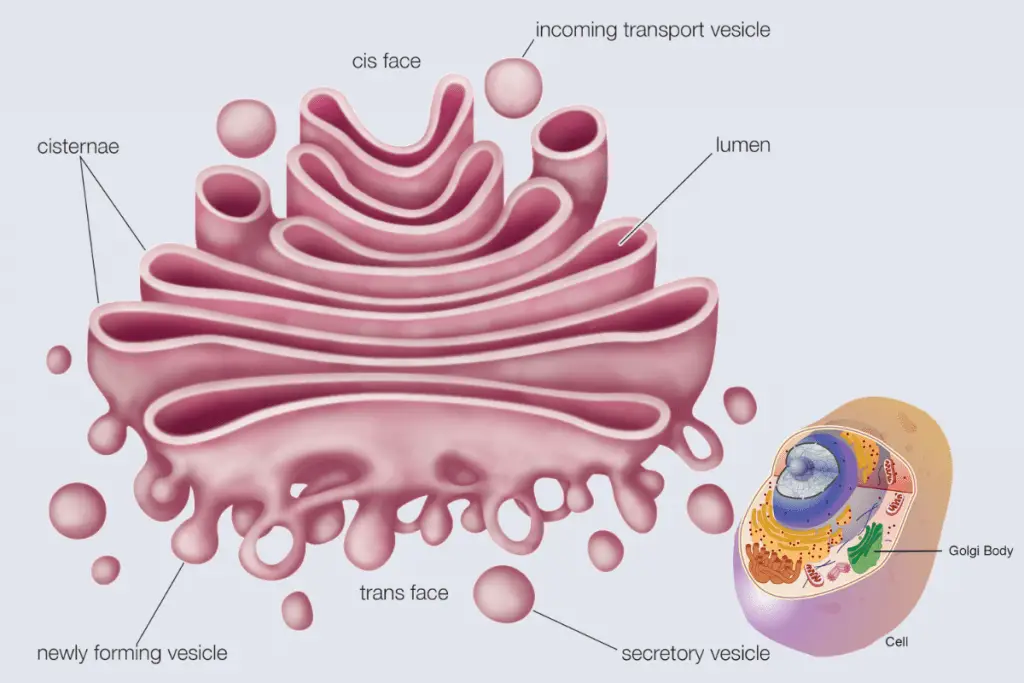
Structure of Golgi Complex
- Golgi Complex is formed by several flattened, stacked pouches called cisternae.
- Generally golgi complexes are made up of four to eight cisternae but in mammalian cells they are made of 40 to 100 stacks of cisternae. In protists they are made of sixty cisternae.
- A matrix protein helps in keeping together the cisternas and a cytoplasmic microtubule supports the golgi complexes.
- The golgi complex has three main part such as cis, which is cisternae nearest the endoplasmic reticulum, medial, central layers of cisternae, and trans, cisternae farthest from the endoplasmic reticulum.
- The cis and trans portion of glogi complex is responsible for sorting proteins and lipids.
Function of Golgi Complex
- It is also called “traffic police” because it directs proteins and lipids to their destination.
- It helps in sulfation of molecules.
- It helps in synthesis of cell membrane, lysosomes and other organelles.
- Helps in exocytosis of zymogen, mucus, lactoprotein, and parts of the thyroid hormone.
(viii). Intermediate filaments
- Intermediate filaments are the main components of the cytoskeleton which is found in vertebrates, and many invertebrates cells.
- There are present six types of intermediate filaments such as Types I and II – acidic and basic keratins (epithelial keratins, trichocytic keratins), trichocytic keratins (Desmin, GFAP, Vimentin, etc), Type IV (Synemin, Neurofilaments, Syncoilin, etc), Type V – nuclear lamins (Lamins), Type VI (Nestin, Filensin, etc)
Structure of Intermediate filaments
- It contains a family of related proteins.
- A pair of two intertwined proteins formed a coiled-coil structure which is preferred as the central building block of an intermediate filament.
Function of Intermediate filaments
- It provides structural integrity of a cell by holding tissues of various organs.
(ix). Lysozyme
- They are membrane bounded organelles and mainly found in cytoplasm of animal cells.
- These organelles degrade various macromolecules with the help of a hydrolytic enzyme.
- There are present two types of lysozyme such as primary and secondary lysozyme.
- The primary lysozyme has several hydrolytic enzymes such as lipases, amylases, proteases, and nucleases.
- Whereas the secondary lysosome is formed by the fusion of primary lysosomes containing engulfed molecules or organelles.
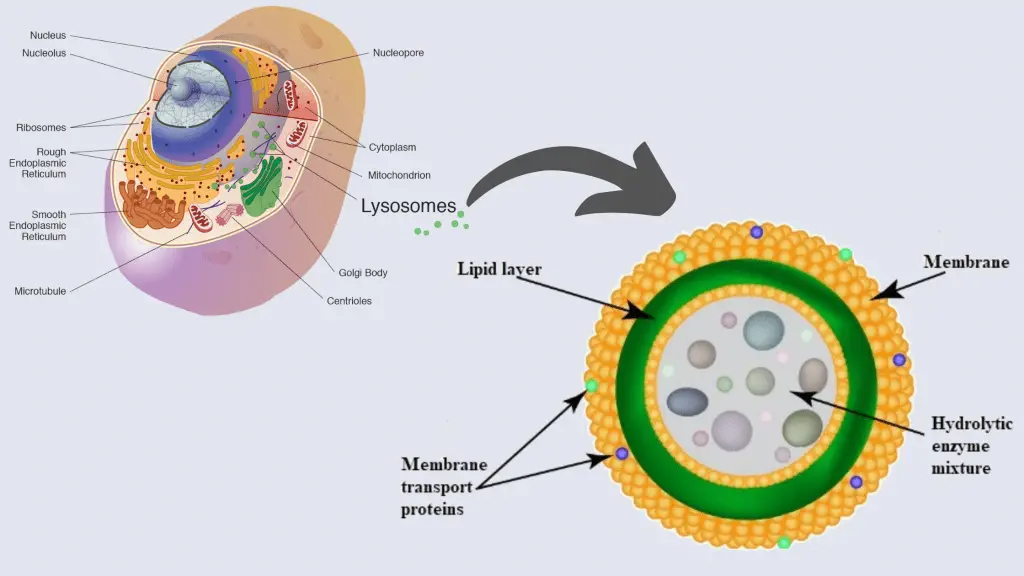
Structure of Lysozyme
- They have an irregular or pleomorphic shape but mostly they appear in spherical or granular structure.
- A lysosomal membrane is present around the Lysosomes which contain different types of hydrolytic enzymes. This membrane protects the other organelles in cytoplasm from harmful enzymes.
Function of Lysozyme
- They help in intracellular digestion of larger macromolecules, where the enzymes which are present in lysozyme degrade the larger macromolecules into smaller molecules.
- They also help in autolysis of unwanted organelles.
- They also help in secretion, plasma membrane repair, cell signaling, and energy metabolism.
(x). Microfilaments
- Microfilaments are also known as the actin filaments, because they are the polymer of a protein called actin.
- It is a network of protein filaments which provides cell structure and keeping organelles in place by extending throughout the cell.

Structure of Microfilaments
- These are referred to as the thinnest filaments of the cytoskeleton by having a diameter of about 6 to 7 nanometers.
- It is made of two strands of actin protein subunit which is wound in a spiral.
- When actin subunits come together and form a microfilament are known as globular actin or G-actin, and when they join together are known as the filamentous actin (F-actin).
- The one end of microfilament is positively charged and the other one is negatively charged.
Function of Microfilaments
- They help in Muscle Contraction.
- They also help in Cell Movement.
- They help in cell division during the mitosis.
(xi). Microtubules
- These are the polymers of tubulin protein which separate them into microfilaments.
- Microtubules are the part of cytoskeleton and provide structure and shape to eukaryotic cells.
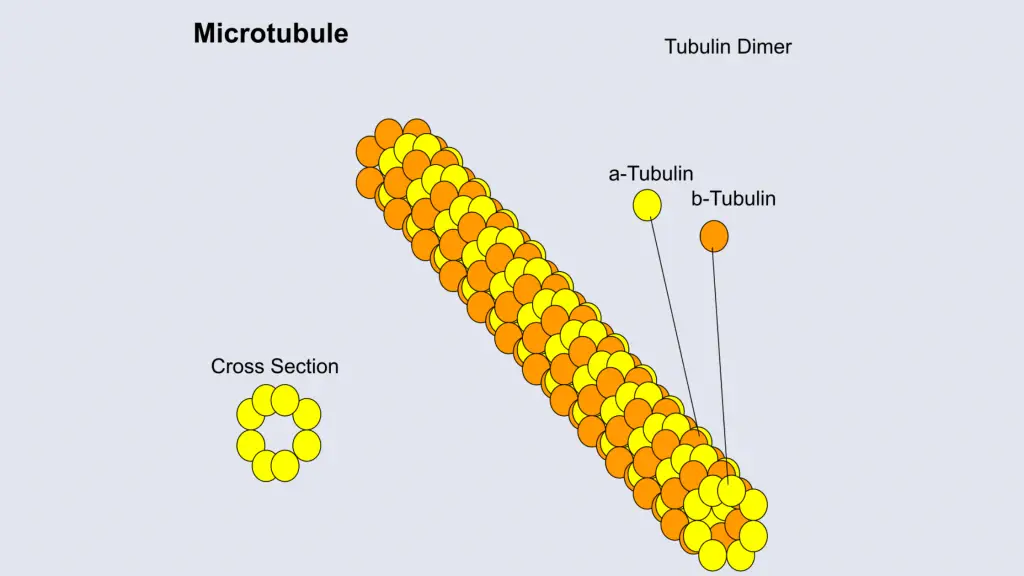
Structure of Microtubules
- Microtubules are 50 micrometres long and the outer diameter is between 23 and 27 nm and inner is between 11 and 15 nm.
- The microtubules are long, hollow cylindrical shapes and are composed of polymerised α- and β-tubulin dimers.
- The inner space of hollow microtubule cylinders is known as lumen.
- Like microtubules the microfilaments have a positively charged and negatively charged end.
Function of Microtubules
- Microtubules help in Cell migration.
- They also help in structure formation of eukaryotic cilia and flagella.
- These are essential for formations of cytoskeleton.
(xii). Microvilli
- The finger-like structures which are projected on or out of the cells are called Microvilli.
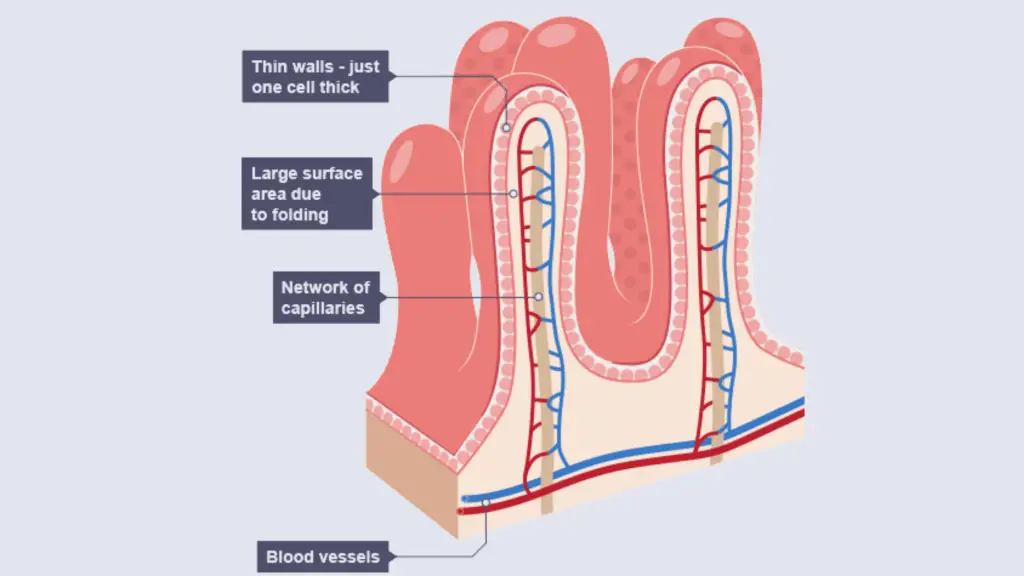
Structure of Microvilli
- These are the bundles of protuberances which are arranged on the surface of the cell.
- They are surrounded by a plasma membrane enclosing cytoplasm and microfilaments.
Function of Microvilli
- In the gastrointestinal tract they help in nutrient absorption.
- They increase the surface area of cells.
- The membrane of Microvilli contains enzymes which break down complex nutrients into simpler compounds.
- During fertilization they act as an anchoring agent in WBCs and in sperms.
(xiii). Peroxisomes
- It is a membrane-bounded organelle found in the cytoplasm of eukaryotic cells.
- They contain enzymes that help in the oxidation of molecules such as fatty acids and amino acids. As a result of the oxidation reaction they produce hydrogen peroxide, that is why they are named peroxisome.
- Hydrogen peroxide is toxic to cells that’s why it contains another enzyme called catalase which converts the Hydrogen peroxide into water and oxygen and neutralizes the toxicity.

Structure of Peroxisomes
- They are made of a single membrane and granular matrix which are scattered in the cytoplasm.
- They appear scattered in the cytoplasm.
- They have different types of enzymes such as urate oxidase, D-amino acid oxidase, and catalase.
Function of Peroxisomes
- They help in oxidation of specific biomolecules.
- They help in biosynthesis of membrane lipids called plasmalogens.
- In plant cells during photorespiration they help in recycling of carbon from phosphoglycolate.
(xiv). Plasmodesmata
- Plasmodesmata is a small passage or channel which is formed in cell walls of plant cells and some algal cells.
- These channels help in transport and communication between two neighboring cells.
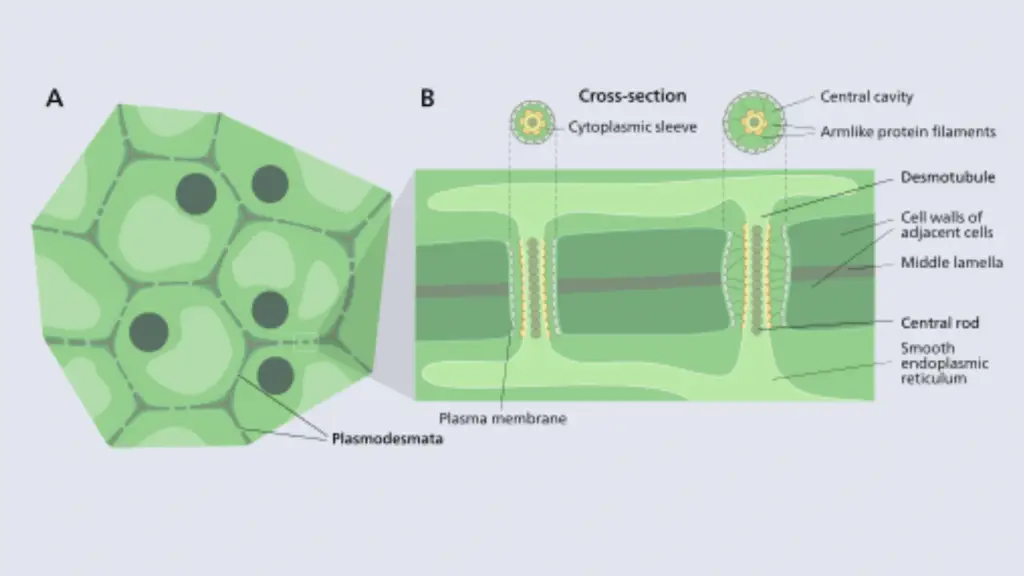
Structure of Plasmodesmata
- A plant cell has approximately 103 – 105 plasmodesmata which connect with the adjacent cells.
- The diameter of a Plasmodesmata is about 50–60 nm.
- Plasmodesmata can traverse up to 90 nm thick cell walls.
- They contain three layers such as the plasma membrane, the cytoplasmic sleeve, and the desmotubule.
- The plasma membrane is a continuous extension of the cell membrane or plasmalemma and has a similar phospholipid bilayer structure.
- The cytoplasmic sleeve is a fluid-filled space enclosed by the plasmalemma and is a continuous extension of the cytosol. Trafficking of molecules and ions through plasmodesmata occurs through this space.
- Desmotubule which is a part of the endoplasmic reticulum that provides a network between two cells and allows the transport of some molecules.
Function of Plasmodesmata
- It helps in transfer of proteins, RNA, and viral genomes between two adjacent cells.
(xv). Plastids
- These are double membrane organelles which are mainly found in plant and algal cells and also in some eukaryotic organisms.
- Sometimes they contain pigments which help in photosynthesis of cells.
- There are present different types of plastids such as; Chloroplasts, Chromoplasts, Gerontoplasts, Leucoplasts.
Structure of Plastids
- These are oval or spherical shapes with a double membrane. The membrane contains two layers such as outer and an inner membrane. The gap between the inner and outer membrane is called an intermembrane space.
- The grana is suspended within the stroma which is enclosed by the inner membrane.
- Grana is made of sac-like thylakoids piled one on the other and connected by stroma lamellae.
- Plastids carry both nucleic acids such as DNA and RNA that allows it to synthesize essential proteins which are required for different processes.
Function of Plastids
- It is the main center for many metabolic activities such as photosynthesis.
- They help to store the foods such as starch.
(xvi). Ribosomes
- These are present in all living cells as free particles or attached to the membranes of the endoplasmic reticulum (eukaryotic cells) and function as the site of protein synthesis.
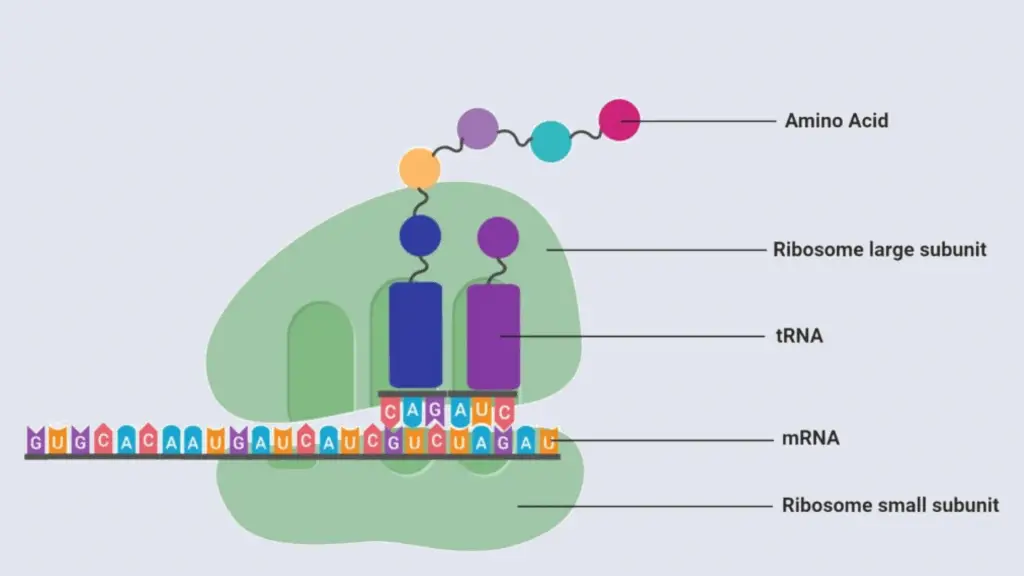
Structure of Ribosomes
- Ribosomes consist of ribosomal RNA and dozens of ribosomal proteins, these are arranged and formed two distinct subunits such as the small subunit and large subunit.
- The eukaryotic cell contains 80s ribosome with 40S smaller subunit and 60S larger subunit.
- The prokaryotic cell contains 70S ribosome where it has a 50S large subunit and 30s smaller subunits.
Function of Ribosomes
- Ribosomes help in protein synthesis.
- They involve protein folding.
- Ribosomes array the amino acids in the order designated by tRNA and assist in protein synthesis.
(xvii). Storage granules
- Storage granules are also known as zymogen granules that store cell’s energy and other metabolites.
Structure of granules
- They contain a lipid bilayer and are made of phosphorus and oxygen.
- The components within these storage granules depend on their location in the body with some even containing degradative enzymes yet to participate in digestive activities.
Function of granules
- It helps to store nutrients and reserves in both prokaryotes and eukaryotes.
- In prokaryotes Sulfur granules utilize hydrogen sulfide as an energy source.
(xviii). Vacuole
- Vacuole refers to an empty space within the cytoplasm which is a membrane-bound structure filled with fluid.
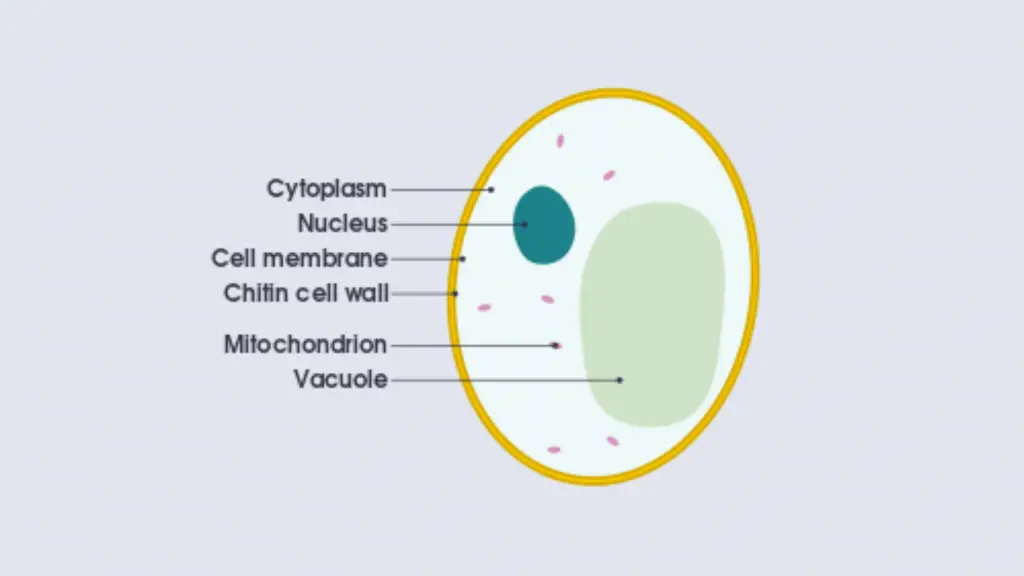
Structure of Vacuole
- It has a membrane called tonoplast, which contains a fluid mixture of inorganic materials and organic materials such as nutrients and even enzymes.
- Vacuoles are similar to vesicles because they form When vesicles are fused.
Function of Vacuole
- They store the nutrients.
- They also store waste materials.
- They involve homeostasis, where they balance the pH of the cell by influx and outflow of H+ ions to the cytoplasm.
- They also contain different enzymes for different metabolic reactions.
(xix). Vesicles
- Vesicle is a structure which is present within or outside a cell.
- They can be formed both naturally (during the processes of secretion (exocytosis), uptake (endocytosis) and transport of materials within the plasma membrane) and artificially. The artificially formed Vesicles are called liposomes.
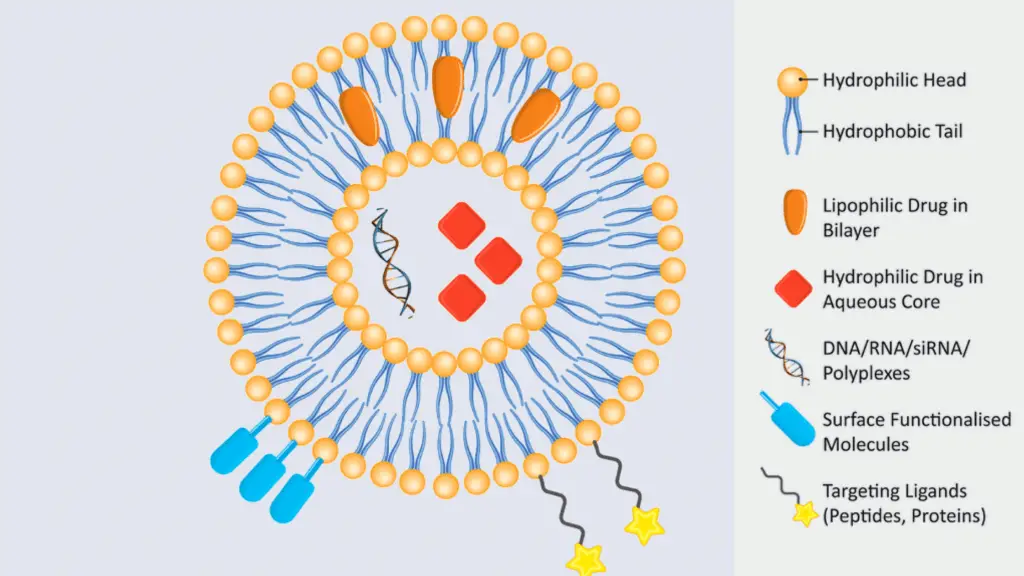
Structure of Vesicles
- They are composed of liquid or cytoplasm enclosed by a lipid bilayer.
- The outer layer of vesicles is similar to plasma membranes, which is enclosing a liquide.
- It has a lipid bilayer with hydrophobic and hydrophilic end.
Function of Vesicles
- It involves the storage and transport of materials.
- It also helps in exchange of molecules between two cells.
- They also function in metabolism and enzyme storage.
Functions of Cell
- Maintains Support and Structure: Cell provides the support and structure to animals, plants, etc.
- Reproduction: Cells help in mitosis and meiosis during the reproduction processes.
- Energy: Cells help in energy production in animals and plants.
- Facilitate Growth Mitosis: Cells facilitate the growth of organisms during the mitosis process by dividing into daughter cells from the parent cells.
- Transport of Substances: Cells transport various nutrients and small substances including oxygen, carbon dioxide, and ethanol, which are essential for chemical processes going on inside the cells.
References
- https://en.wikipedia.org/wiki/Cell_(biology)#Cell_types
- https://www.khanacademy.org/test-prep/mcat/cells/eukaryotic-cells/v/the-nucleus
- https://biologydictionary.net/microfilament/
- https://en.wikipedia.org/wiki/Vesicle_(biology_and_chemistry)
- https://www.britannica.com/science/cell-biology/Actin-filaments#ref37428
- https://byjus.com/biology/cells/
- http://www.biology4kids.com/files/cell_nucleus.html
- https://microbenotes.com/cell-organelles/

Quality content is the secret to invite the visitors to pay a visit the site, that’s what this website is providing.
Since the admin of this web site is working,
no question very shortly it will be renowned, due to its quality contents.
Hi, after reading this remarkable post i am as well cheerful to share
my familiarity here with mates.
thank you
There is perceptibly a bunch to know about this.
I suppose you made certain nice points in features also.
Thank you